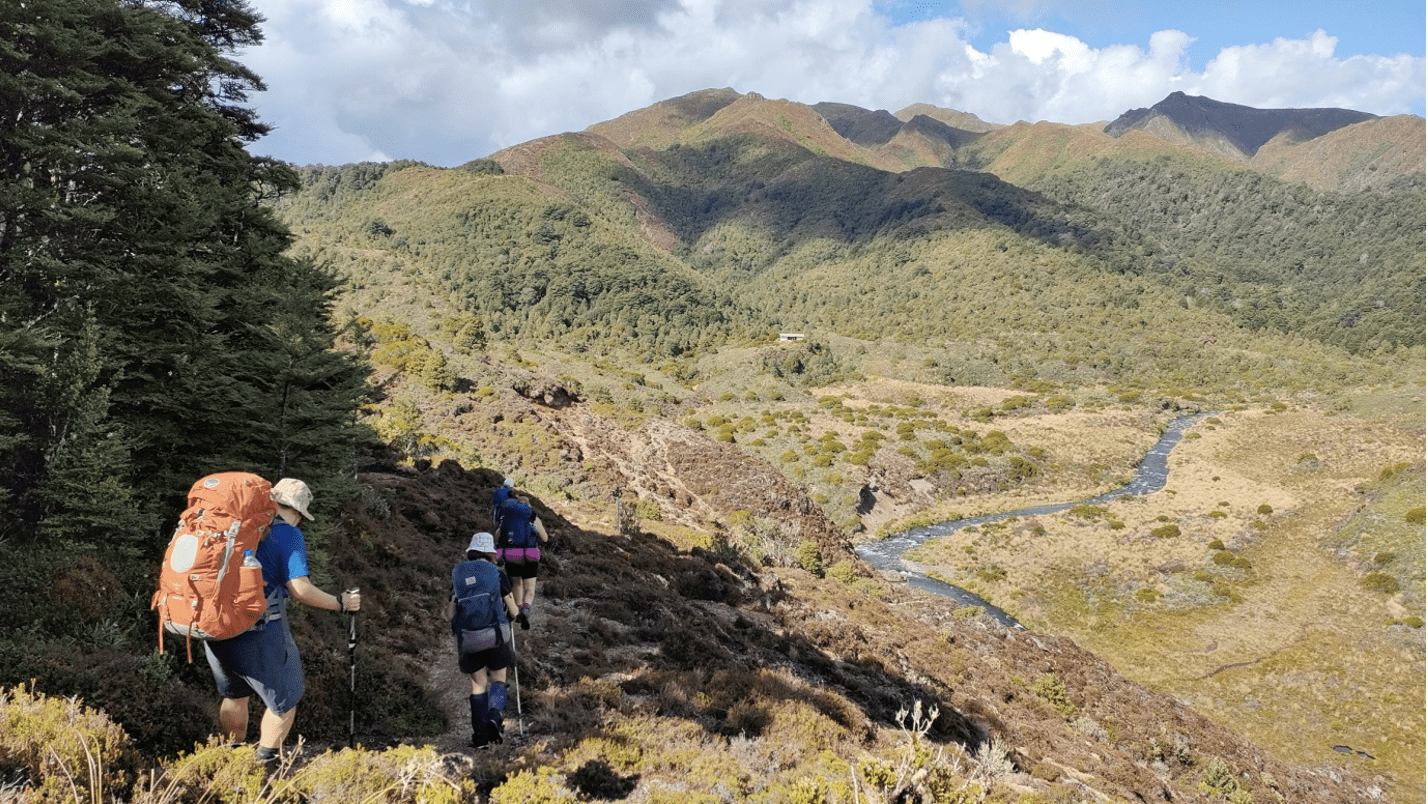Disclaimer: This trip report was written by ChatGPT.
Trip start date – 17 March 2023: I can’t think of a better way of reconnecting with my deep and treasured Irish roots on St Patrick’s Day than a dry, teetotalling WTMC club tramp along the famously brown volcanic Central Plateau. I do not speak of hiking around Mt Ruapehu. No sirree! The sad decline of Tongariro National Park, the shutting of the 90-year-old Chateau, the placing of the financially distressed Ruapehu Alpine Lifts under administration, and the consequent probable loss – if the company folds – of my lifetime ski pass to Whakapapa and Turoa ski fields (of which, two members on this trip were holders) had permanently soured my opinion on that tired tourist trap. No, I was taking my custom eastwards, across the Desert Rd, to the neighbouring Kaimanawa Ranges, on a return weekend tramp to Waipakihi Hut, along Umukarikari Track.
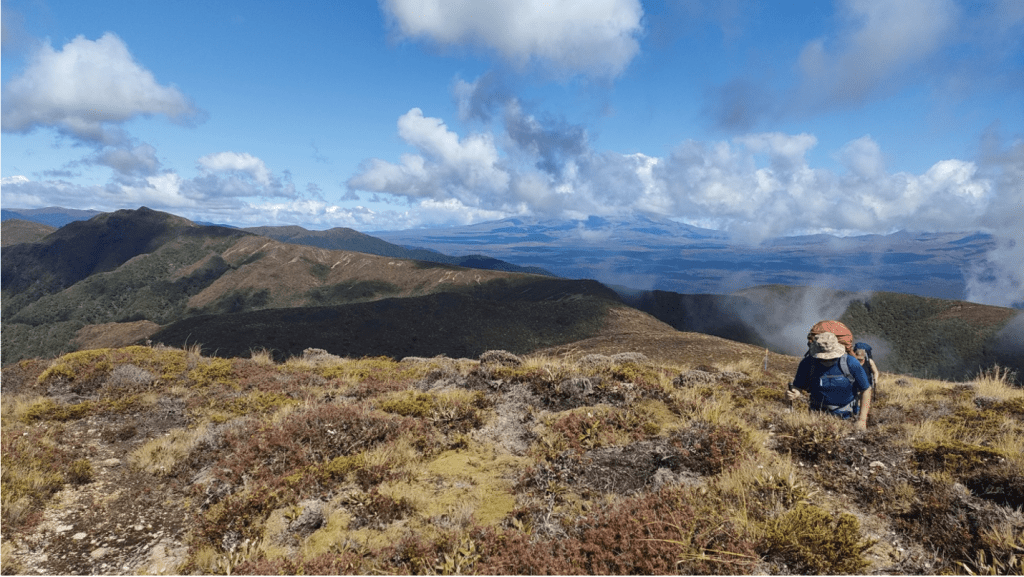
According to the DOC brochure, the word “Kaimanawa” comes from “the words of Hapekituarangi. On his travels he met Ngātoro-i-rangi of the waka Te Arawa who asked him why he was in such a cold and barren country. Hapekituarangi looked towards the Kaimanawa Ranges and replied ‘My breath (manawa) is my food (kai).’” Well, some of us like cold, barren and windy. Some of us would rather cut off our nose to spite our own face by going to the Kaimanawa Ranges, because they’d sworn off ever setting foot in Tongariro National Park again. VENGEANCE FOR MY LIFE SKI PASS.
To understand my motivation for signing up for this trip is to understand the betrayal I felt from Ruapehu Alpine Lifts. The lifetime ski pass cost me a lot of money ($3950) when I bought it in 2017 from the not-for-profit. I was in my twenties, and I’d expected to have a long full life’s worth use of it. I had this dream that my life pass would help me find a life partner as passionate about snow sports as me, and we’d raise a family on the slopes. I’d get to see the first dusting of Whakapapa snow settle on my little son’s nose, and see his face light up in his wee blue bobble hat as he experienced skiing on Mt Ruapehu for the first time. I’d start a family tradition – yearly trips in the winter school holidays with my children. The love of snow would get engrained in them, so the tradition I founded would be passed down from generation to generation: from my children to my children’s children. In my old age, I would look out from the slopeside restaurant at my grandchildren snowball fighting, my life ski pass still valid. I hoped to die of old age during the ski season. My last act: the ski pass slipping out of my dying hand as I breathed out my last word – Rosebud, the name of my wife-to-be.
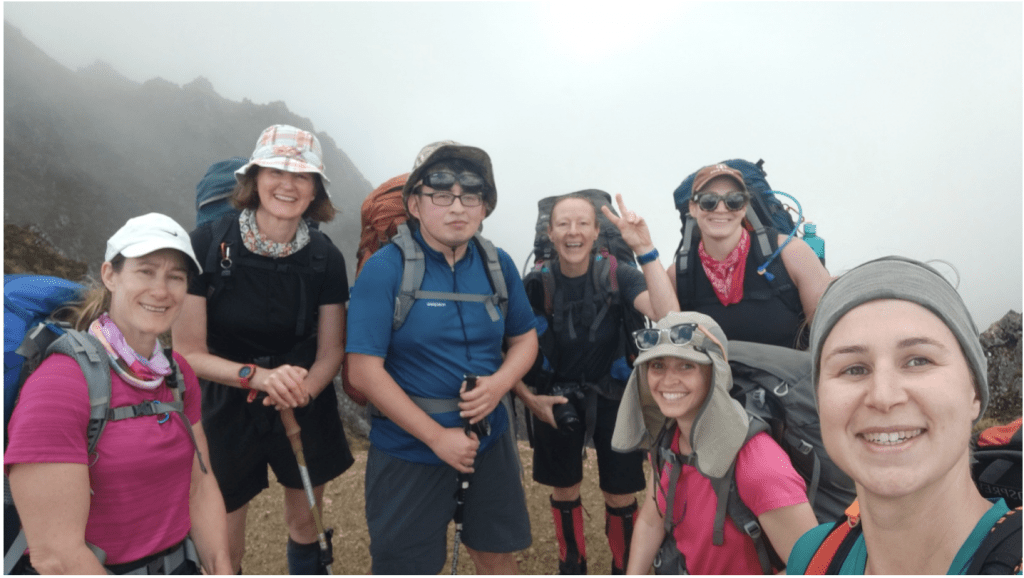
I had two years use out of my life ski pass before the Covid pandemic hit in 2020, followed by some terribly patchy ski seasons – because of that global warming thing. Now that the company looked like it was going under, I had lost it all – all my hopes and dreams for the future. So the Kaimanawa Ranges it was from now on. Mt Ruapehu, adieu.
Back to the club trip. At 5:15 pm on Friday, 17 March, St Patrick’s Day, our WTMC group of seven departed Wellington Train Station in two private vehicles. The trip took place shortly after the club’s Newbie Night. Instead of staying overnight at a typical campsite, the trip leader had booked us shared rooms at a motel (at a SVB bank breaking $33 charge pp). The leader’s see-through ploy to take us glamping: there was a MetService “heavy rain warning” forecast and she wanted to coddle the new easy-medium trampers and spare everyone the miserable task of setting up tents in a pitch-black deluge. Yet when we arrived at Waiouru Roadside Motel at 9:30 pm, the night was clear and still.
At the motel (situated off SH1, next to the Z petrol station), we traded the tranquil sounds of nature for the rumble of trucks hurtling by all night aswe failed to sleep. Calming cricket song was replaced by engine brake noise, and the thrumming and rattling of the motel’s antiquated “water hammer” plumbing system working out air trapped in the pipes. The Tramping Gods were not happy with us being big softies- as the fuse blew the next morning and we had to eat our breakfast in the dark. Later on we had a conversation with a hunter who had camped overnight at Kaimanawa Forest Park. He said he had been absolutely drenched – this may have validated the trip leader’s sense in booking a motel.
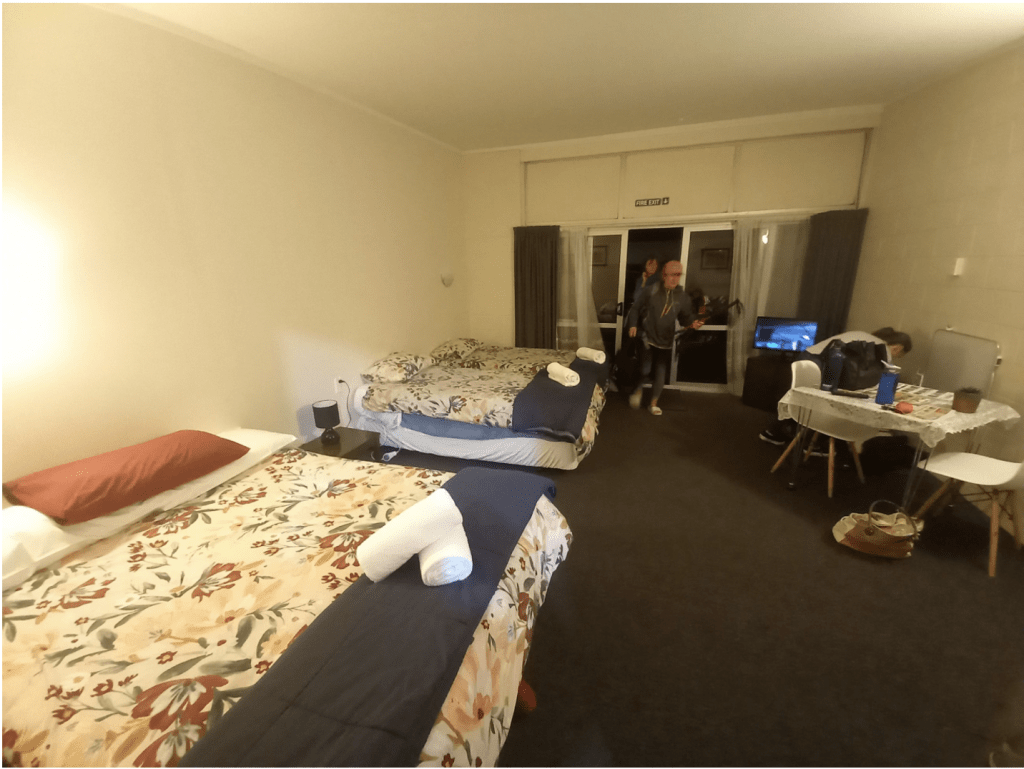
On Saturday we arrived at the Kaimanawa Forest Park roadend at 9 am, and set out along Umukarikari Track towards Waipakihi Hut through beech forest. The forest floor was firm underfoot and not muddy. The path was wide, well signposted and clear to follow, with the occasional tree fall blocking the track. The trek to the hut began with a steady 2-hour ascent up through the forest to the treeline. For this reason, I cannot recommend this trip for socialising. All our ragged breaths were devoted to supplying oxygen to our climbing legs, not chit-chat. The awkward silence allowed us to focus our attention on internal aspects of tramping: like leather boots rubbing our feet raw, creating blisters.
Above the treeline, the track flattened out along the ridgeline. The bare and barren, stony scree tops resembled the surface of a shale quarry or open-cast mine. The group rejoiced seeing the trees disappear, as they had been blocking the view, and rushed to take photos. Oh, if only every tree could be expunged and Aotearoa could turn into mines – that would be every tramper’s heartfelt desire.
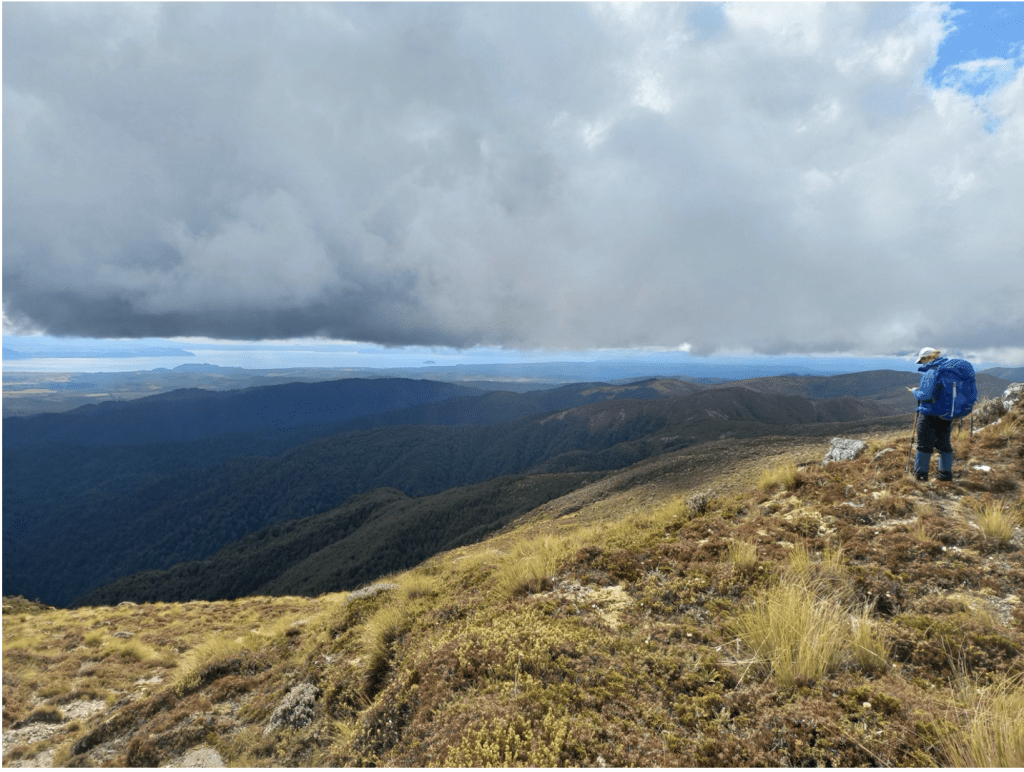
The weather on the tops was still and pleasantly mild, with light cloud cover. For about an hour, our photographers were rewarded with sweeping vistas out to Lake Taupo and the valleys below. In the other direction, Mt Ruapehu was uncooperatively sulking and swaddled in clouds. However, some low-lying cloud fluff began to rapidly spoil our view. The clouds (or fog) started streaming in and was soon curling around the ridgeline. Visibility swiftly deteriorated. The mists of Inisherin, summoned by St Patrick’s Day, had swallowed us up. Into this unearthly fog we walked, guided by the blue marker signposts that loomed, gaunt and ghostlike, up from the gloom.
Near the end, the narrowing track fell sharply to an unnecessary and vindictive small river crossing within sight of the hut. The only reason for the river’s existence was to force us to squelch our way up to Waipakihi Hut disgruntled with cold and dripping wet socks and boots. We arrived at our destination at 3:30 pm, allowing us to each claim a bed in the 12-bed hut.
At WTMC’s Newbie Night this year, Monique said that one of New Zealand’s greatest achievements was its hut network. I say that work on the hut network is not yet complete. Not until huts have hot showers, flush toilets and electric lighting – perhaps powered by solar panels. I’m not one to bag on huts but… sure, Waipakihi Hut had four walls, a central kitchen, a fireplace, separate 6-capacity bunk rooms, two cold water taps (water sourced from a tank) and the usual long drop and covered deck. But where was the cellular phone coverage? Where was the pool table? Where was the Wi-Fi? – to livestream my hut experience to my friends on social media. Where was the spa pool? Where was that certain je ne sais quoi of a landscape designer’s attention in the form of a well-manicured Chinese garden? You know what? …. the next generation 5G hut network needs to be a hut UberEats network.
The billy was soon bubbling away and the pungent aroma of feta and mixed vegetable couscous began filling the kitchen – our shared vegetarian dinner. I bore a special grudge against this meal. As part of my gear allocation, I had been forced to cart 750g of “seasonal vegetables” (courgettes), when 100g of bacon would have provided the same calorific content. Vegetables, I maintain, are for children. Vegetables are something parents force children to eat. Speaking for myself, as soon as I got older and could choose my own meals, I outgrew them (exchanging them with cocoa puffs and chicken nuggets) and it’s been a long time since I ate a vegetable. To me, the sign of a strong and independent man or woman, who has flown the coop of their parent’s home and has the freedom to live in their own place, is the ability to choose to eat yummy, yummy, scrumptious food: birthday cake for breakfast and meat lovers pizza for dinner every day of the week. No icky yucky veggies in sight!
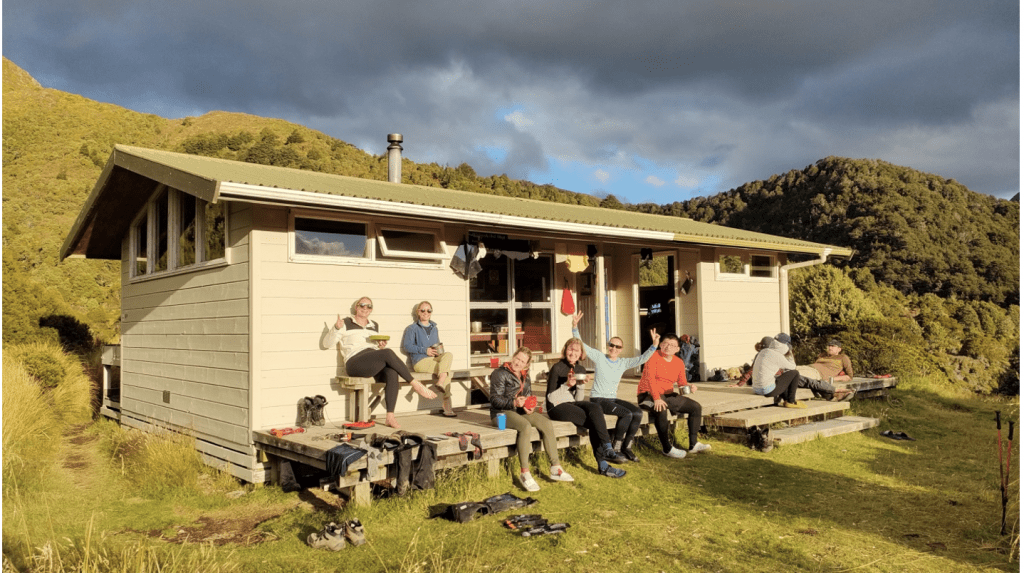
After everyone had eaten a plate of the unappetizing sticky vegetarian gloop (couscous is also exceptionally hard to wash up), there was still plenty left over in the billy. Inexplicably, the other hut guests (a hunter, a group of four, and a couple) did not want any. Eventually, the rest was fed to the hunter’s dog, named Spud, who adored the onions. [Author’s note: never feed onions to cats or dogs as it is toxic to them and causes anaemia. Once the registered nurse in our group remembered the veggie couscous had onions in it, we immediately stopped giving it to the dog.]
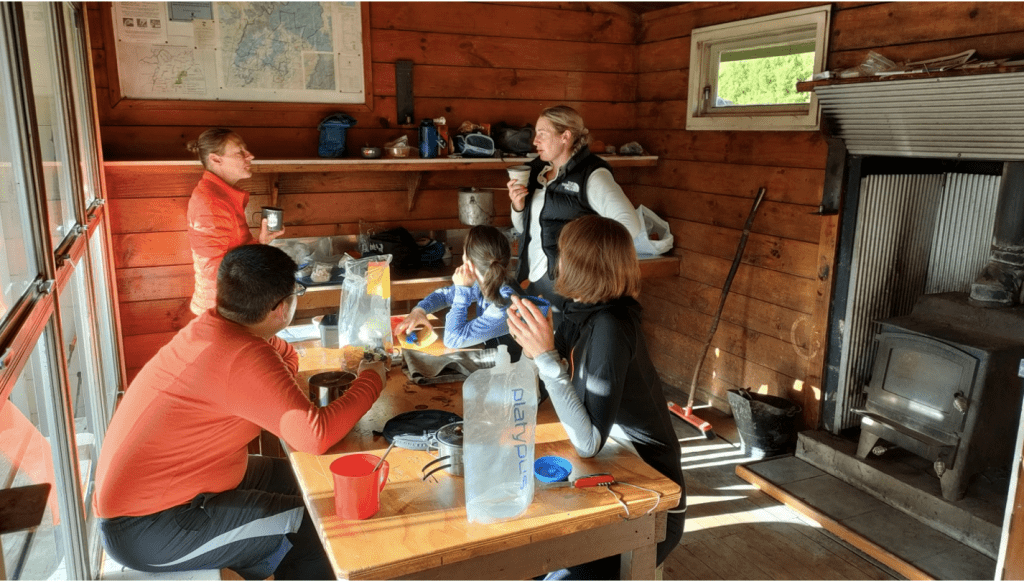

Night settled in and people withdrew to bed. My apologies if I kept people awake with the white glare of my smartphone screen. It takes a long time for me to fall asleep. I needed to recite my sleep affirmations and watch three K-drama episodes. Finally, reading a Victorian-era novel (The Woman in White (1859) by Wilkie Collins) on my phone (for my other club – a book club) got me to doze off. A quote stuck in my mind as I finally drifted off to sleep: “[The novel] attracted more of my attention than the finest view we passed through, or the grandest changes of light and shade, as they flowed into each other over the waving moorland and the level beach. At any time, and under any circumstances of human interest, is it not strange to see how little real hold the objects of the natural world amid which we live can gain on our hearts and minds? We go to Nature for comfort in trouble, and sympathy in joy, only in books. Admiration of those beauties of the inanimate world, which modern poetry so largely and so eloquently describes, is not, even in the best of us, one of the original instincts of our nature. As children, we none of us possess it. No uninstructed man or woman possesses it. Those whose lives are most exclusively passed amid the ever-changing wonders of sea and land are also those who are most universally insensible to every aspect of Nature not directly associated with the human interest of their calling. Our capacity of appreciating the beauties of the earth we live on is, in truth, one of the civilised accomplishments which we all learn, as an Art; and, more, that very capacity is rarely practised by any of us except when our minds are most indolent and most unoccupied. How much share have the attractions of Nature ever had in the pleasurable or painful interests and emotions of ourselves or our friends? What space do they ever occupy in the thousand little narratives of personal experience which pass every day by word of mouth from one of us to the other? All that our minds can compass, all that our hearts can learn, can be accomplished with equal certainty, equal profit, and equal satisfaction to ourselves, in the poorest as in the richest prospect that the face of the earth can show. There is surely a reason for this want of inborn sympathy between the creature and the creation around it, a reason which may perhaps be found in the widely differing destinies of man and his earthly sphere. The grandest mountain prospect that the eye can range over is appointed to annihilation. The smallest human interest that the pure heart can feel is appointed to immortality.”
The trip back to the road end along the same track was exactly like the first day, just in reverse.
I’d like to thank Jamie for leading a smooth, food poisoning-free, injury-free trip and my trip mates for being well equipped to avoid any emergency situations. I’d also like to thank myself for arranging the rain-free warm weather.

